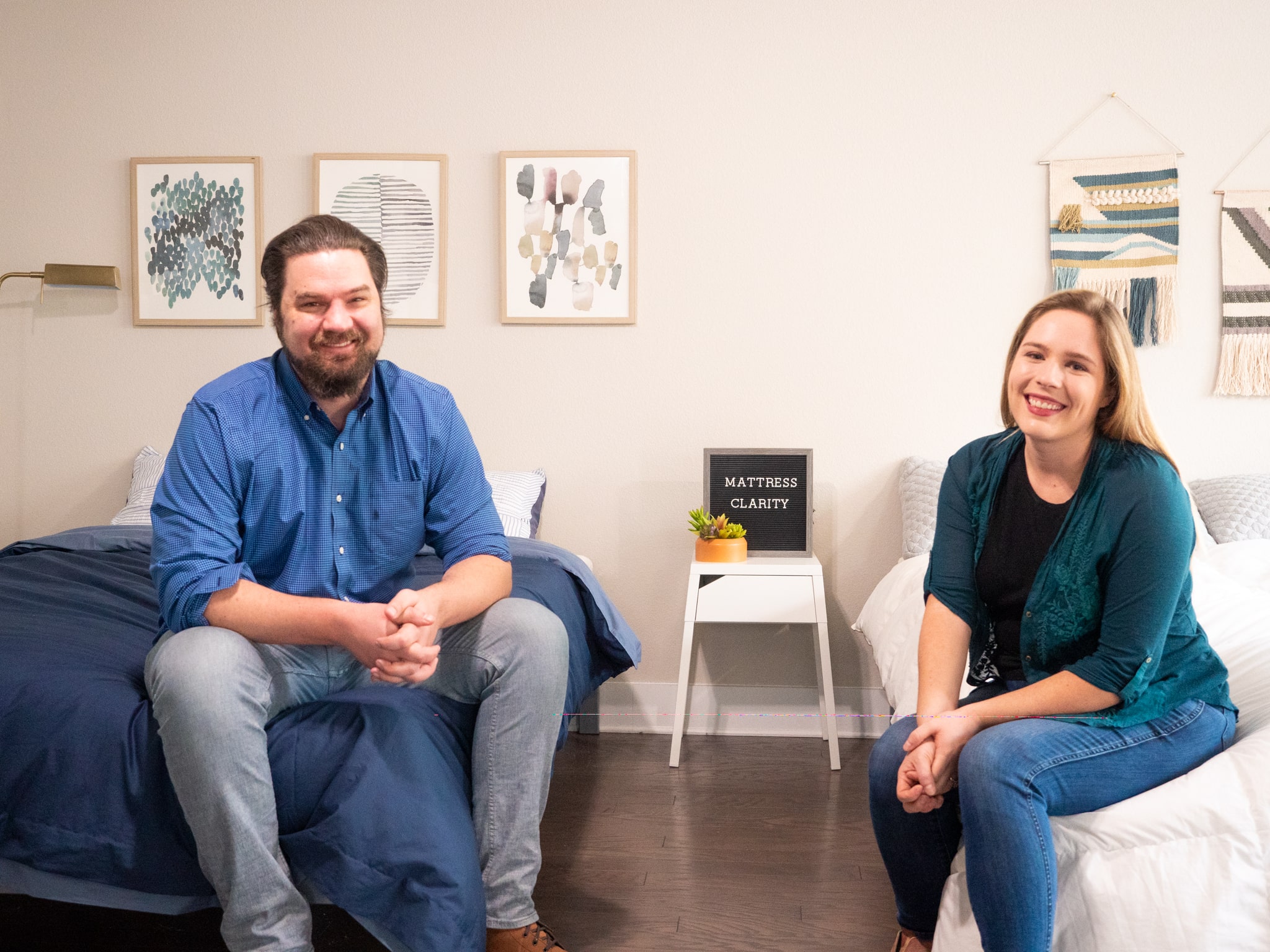If you’re looking to improve your sleep, buying a new mattress can be a daunting process. You want something that’s going to be comfortable, affordable, and suitable for your unique needs. But where to start? That’s where we come in.
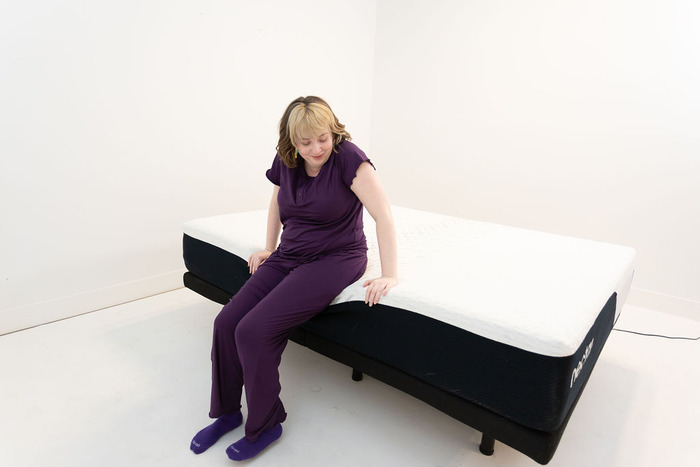
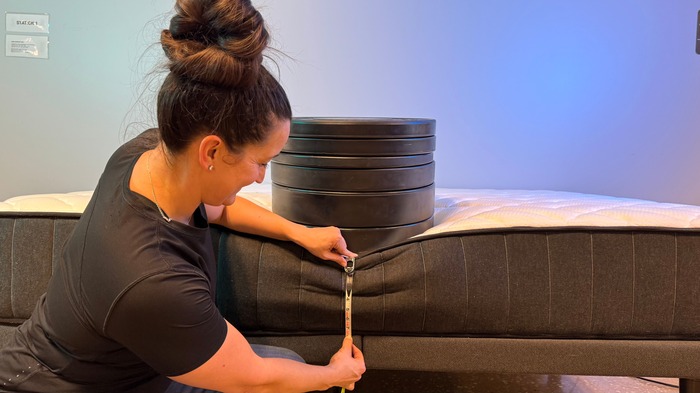

At Mattress Clarity, we aim to make the buying experience a breeze. Our reviews give you the need-to-know information that will help you find the right bed for you. We test each mattress we recommend in our dedicated testing studio. We then use our proprietary analysis to score its pressure relief, cooling, edge support, and a whole lot more, before assigning the bed an overall score.
Here’s a closer look at the performance categories we test and how we score them.
Testing Mattress Feel and Performance
These tests all involve physically interacting with the mattress to judge its feel, functionality, and long-term suitability for different types of sleepers.
Firmness
We rate firmness on a scale from 1 to 10, with 1 being extremely soft and 10 being extremely firm. The “industry average” for mattresses is a 6.5, which feels medium-firm and appeals to most sleepers.

Our team consists of reviewers with different body types, and we also take into account how your size and weight can affect the perceived firmness of your mattress. To calculate a firmness rating, we have different testers lie on the bed and report how firm it feels to them (using numbers from 1 to 10) in different positions. We then average those numbers to produce an overall firmness rating.
Consult our comprehensive mattress firmness guide for a detailed explanation of different firmness levels, their advantages, and their drawbacks.
Comfort for Different Body Types and Sleeping Positions
Although we do our best to be rigorously scientific when we test beds, we also know that how a mattress feels is quite subjective. For example, a heavier person typically experiences a mattress as firmer than a petite person does. That’s why we get a wide variety of perspectives when we review mattresses for body weight.
We also assess how comfortable a mattress feels for different sleeping positions. Most people favor one or two positions when they sleep: side, back, or stomach. Each position is best served by a particular mattress firmness and feel.
- For back sleepers: Is the mattress an even-keel medium-firm that offers a balance of cushion and support?
- For side sleepers: Is the mattress soft enough to relieve pressure on our shoulders and hips?
- For stomach sleepers: Is it a firm mattress that holds up our hips?
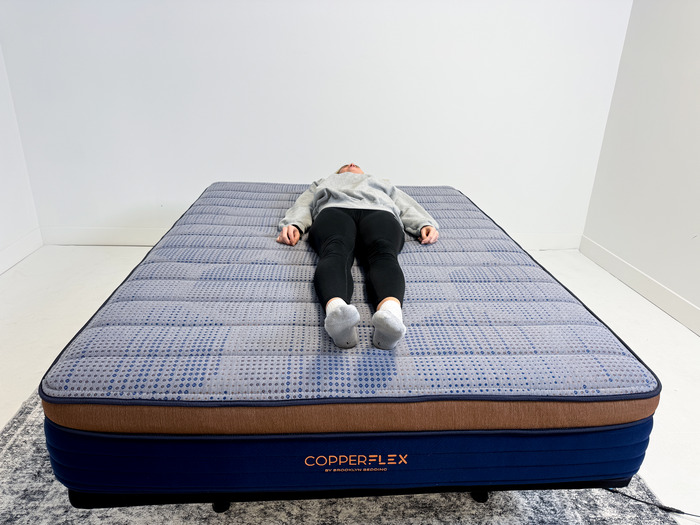
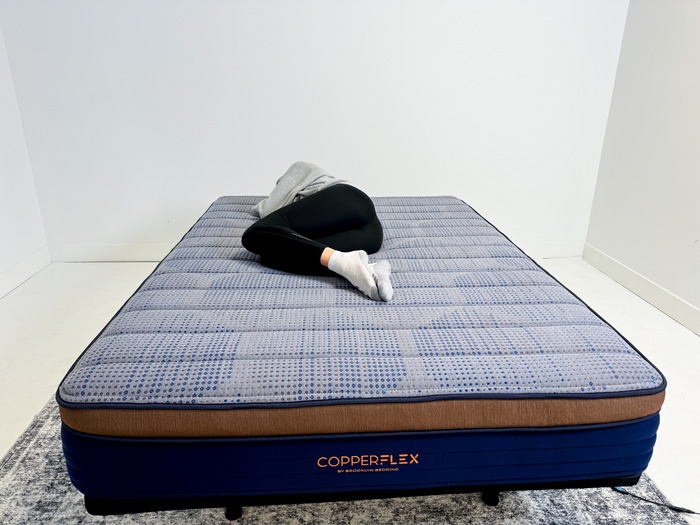
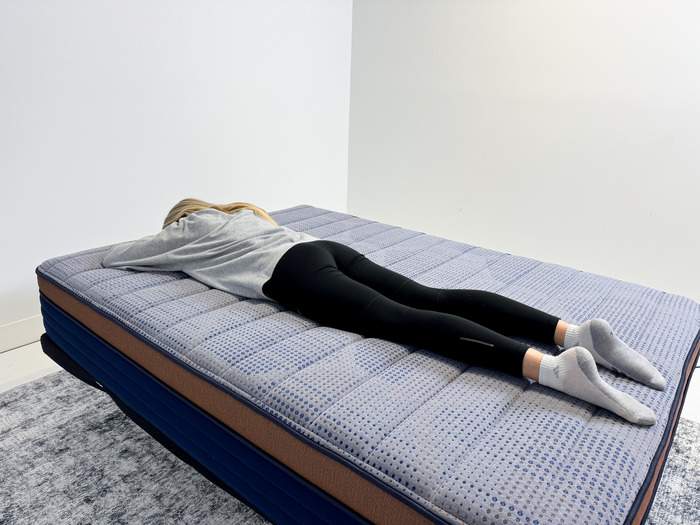
During testing, we have testers of various body types lie on each mattress in all three positions. They take detailed notes on their comfort, whether they feel properly supported, and what stands out to them about the bed’s feel.
Ultimately, the bed receives one of three designations for each combination of body type and sleeping position: Unpleasant, Good, or Excellent. We put these designations in an easy-to-read chart like the one below.
| Sleeper Weight | Side Sleepers | Back Sleepers | Stomach Sleepers |
| Light (under 130lbs) | Unpleasant | Good | Excellent |
| Average (130-230lbs) | Good | Excellent | Excellent |
| Heavy (over 230lbs) | Good | Excellent | Unpleasant |
Pressure Relief
A mattress that scores high in the pressure relief category has layers that cradle your joints, reducing the concentration of pressure in areas that typically see a lot of it. Side sleepers, for example, commonly experience pressure on their shoulders and hips, as these sharp joints dig into the mattress. Pressure relief is especially important for them!
We test each mattress to see just how pressure-relieving it is. Lying down in all three sleeping positions, our testers ask themselves: Do we feel a build-up of pressure around our joints, or is the mattress easing this pressure?
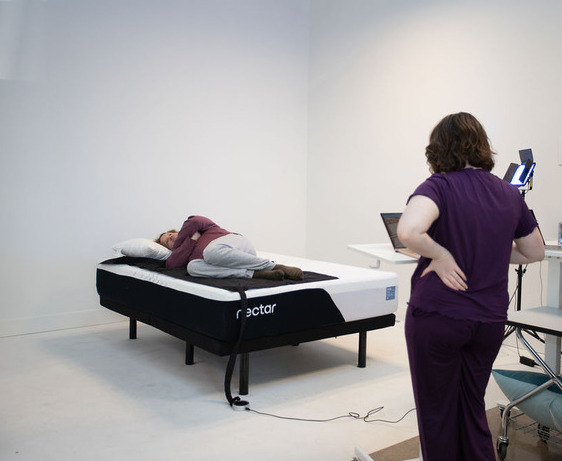
We also utilize an electronic mat to generate pressure maps for each mattress. Multiple testers with different body types lie on this mat in the side-sleeping and back-sleeping positions. (Stomach sleepers need to worry about lift and support more than pressure relief, so we don’t typically test this position.)
The resulting image is color-coded “pressure map” that illustrates where pressure buildup occurred on the testers’ bodies. Red and orange areas indicate high pressure, yellow areas indicate medium pressure, and green and blue areas indicate very low or no pressure.


The mat also displays a PSI (pounds per square inch) reading. This number gives us a sense of the overall pressure being exerted by the tester onto the mat. It’s typical for a side sleeper to have a PSI reading of around 14.58, and for a back sleeper to have one around 12.43. We use these averages as a standard so that we can gauge whether a bed has particularly impressive or mediocre pressure-relieving capabilities.
We assign the bed a pressure relief score between 1 and 5 (5 being the highest score a bed can achieve). To decide on this score, we factor in the readings from the pressure mat as well as reported data from our testers.
Edge Support
A mattress with solid edge support lets sleepers utilize every inch of the mattress. This means partners can sleep all the way toward the edge without rolling or falling off. Edge support is also useful for getting in and out of bed easily, without worrying about the perimeter dipping too much.
We test edge support by sitting and lying right on the edge of the mattress. We record how stable we feel in each position, and whether there seems to be a risk of sliding or rolling off.
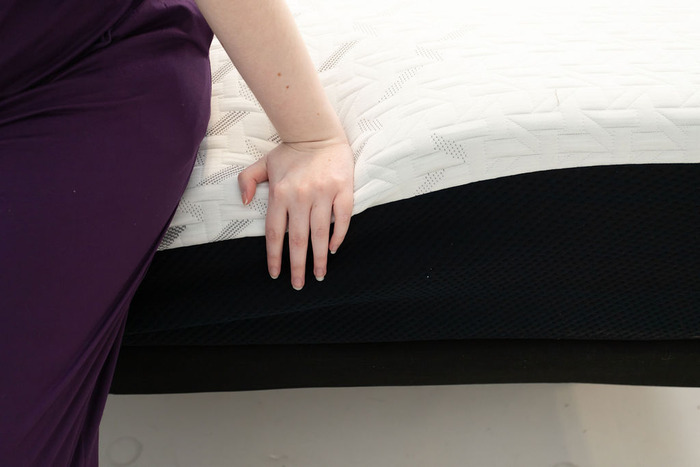
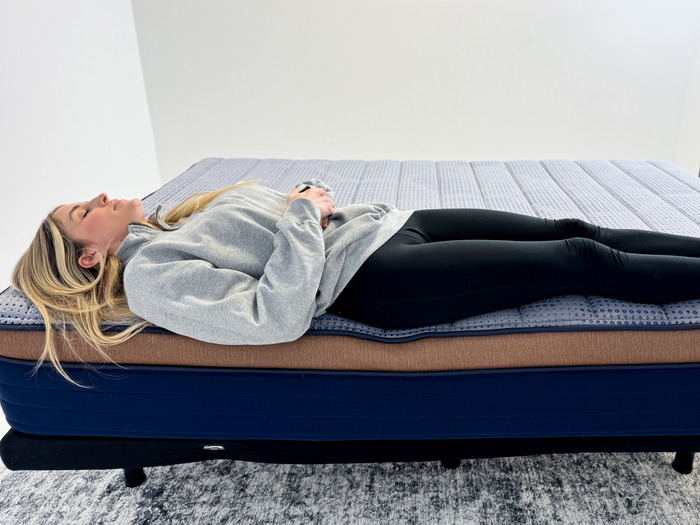

We also place weighted plates on the bed near the edge so we can use a tape measure to tell us exactly how much the edges sink.
Based on the above tests, we assign the bed an edge support score between 1 and 5, with 5 being a perfect score.
Cooling
Many mattresses feature cooling materials meant to prevent sleepers from overheating during the night.
If the mattress features latex or coils, we expect it will run fairly cool, as these materials naturally promote airflow.
While memory foam mattresses are known for trapping heat, some brands infuse the foam with gel, graphite, or copper. These substances can help with heat dissipation and make a mattress feel cool to the touch.
To test a bed’s cooling performance, we lie on the bed for an extended period of time and make note of any fluctuations in temperature we can feel. We also perform a test using a heat-sensitive temperature gun.
First, we use the gun to take the surface temperature of the bed. A tester then lies on the bed for several minutes. After they get up, we take the surface temperature again. The best cooling mattresses will prevent a steep rise in temperature, whereas those without many cooling materials may heat up quickly, showing a change of 10 or more degrees.
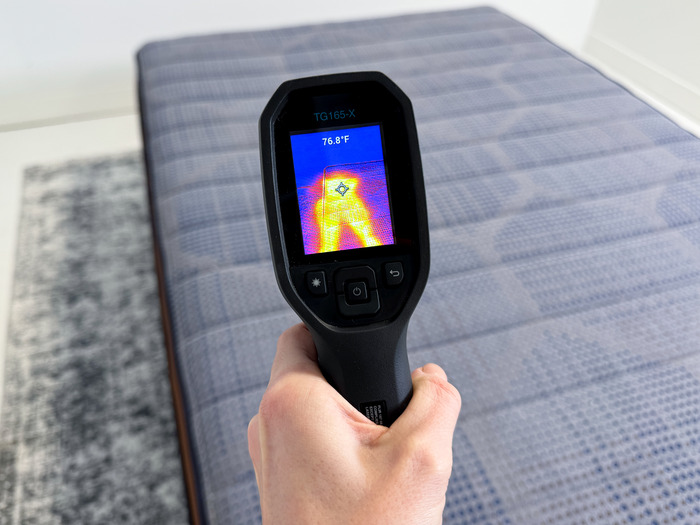
Finally, we give the bed a score from 1-5 for its cooling. Only those with a surface temperature that goes up by less than 10 degrees Fahrenheit will receive an above-average score.
Motion Isolation
Motion isolation refers to a mattress’s ability to dampen or absorb motion. Beds with excellent motion isolation are great for restless couples, as they can prevent one person from waking up while the other tosses and turns.
We run a few tests in order to assess a mattress’s motion isolation. First, we place a glass of water on one side of the bed and then attempt to make a disturbance on the other side. If there is no disturbance in the water, the mattress is isolating motion very well. If there is a good bit of disturbance in the water, motion is transferring across the mattress.

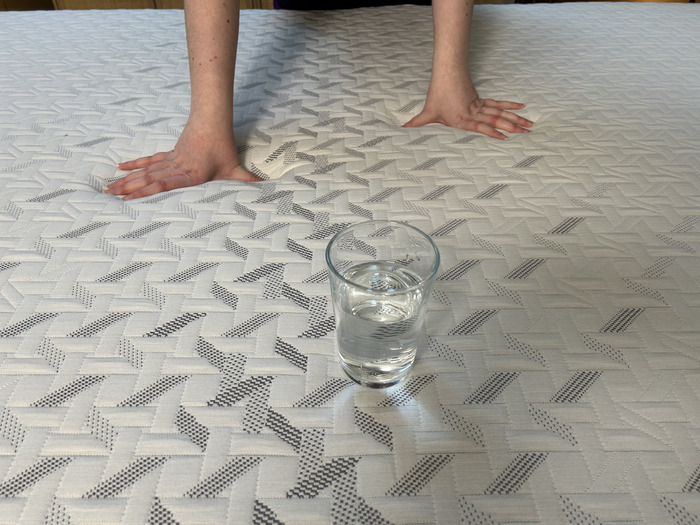
Second, one of our reviewers lies down on one side of the mattress while another reviewer rolls around on the other side, changes positions, and gets in and out of bed. This is meant to mimic what a sleeping partner might do during the night. If the first reviewer is undisturbed on their side of the mattress, the mattress is isolating motion well.
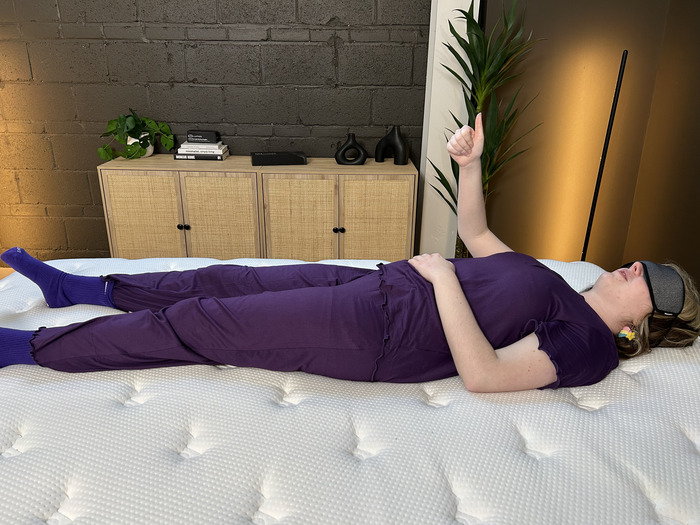
Finally, we drop a medicine ball onto the mattress while measuring the motion across its surface with a seismometer. The flatter the seismometer reading, the better the bed’s motion isolation.
We average the results from the above tests to produce a final motion isolation score between 1 and 5.
Response
A responsive mattress will reform back to its original shape quickly, without lingering body impressions. It will also feel springy and foster ease of movement, rather than sink deeply and make you feel “stuck” in its layers.
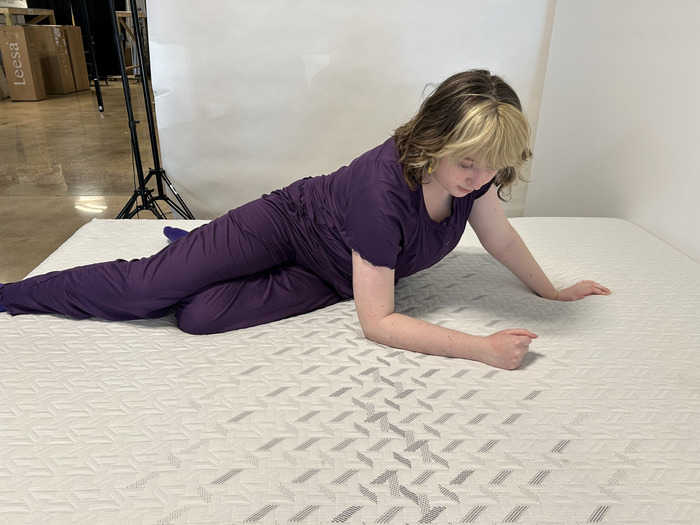
We test a mattress’s responsiveness by rolling around on it and changing positions. If it is a slow-moving memory foam mattress, we may feel great pressure relief but will have trouble moving around. If it is a bouncy latex or hybrid mattress, it will be easier to move around on, but we won’t feel as much contouring or pressure relief.
We give the mattress a response score between 1 and 5, with 5 being extremely responsive.
Sinkage
Sinkage is just what it sounds like: the degree to which the surface of a mattress sinks when weight is applied. Some people prefer a bed with a lot of sink and plushness, whereas others prefer to feel like they’re more on top of the mattress.
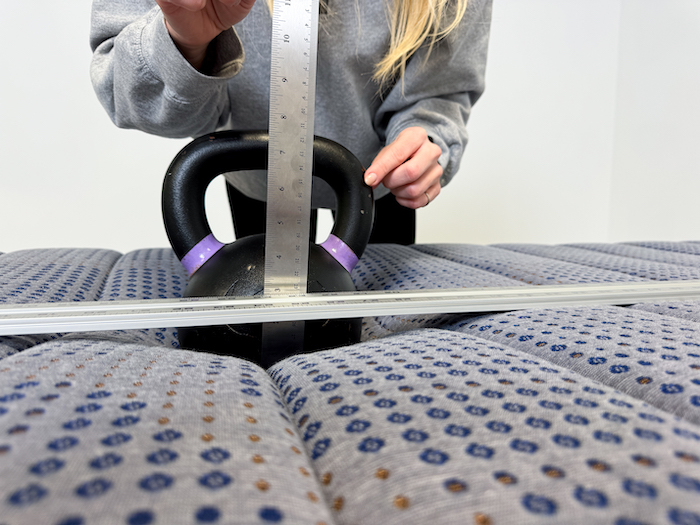
To test sinkage, we place a 44-pound kettlebell on the bed and measure how low it sinks into the mattress surface. On average, it usually sinks about 3 inches.
We use this average to help us assign a sinkage rating to the bed: Light, Moderate, or Deep.
Bounce
Bounce refers to how springy the mattress is, and how forcefully it will push back when pressure is applied. To measure this, we drop a 15-pound medicine ball from a ladder and measure how high it bounces once it’s struck the bed once.
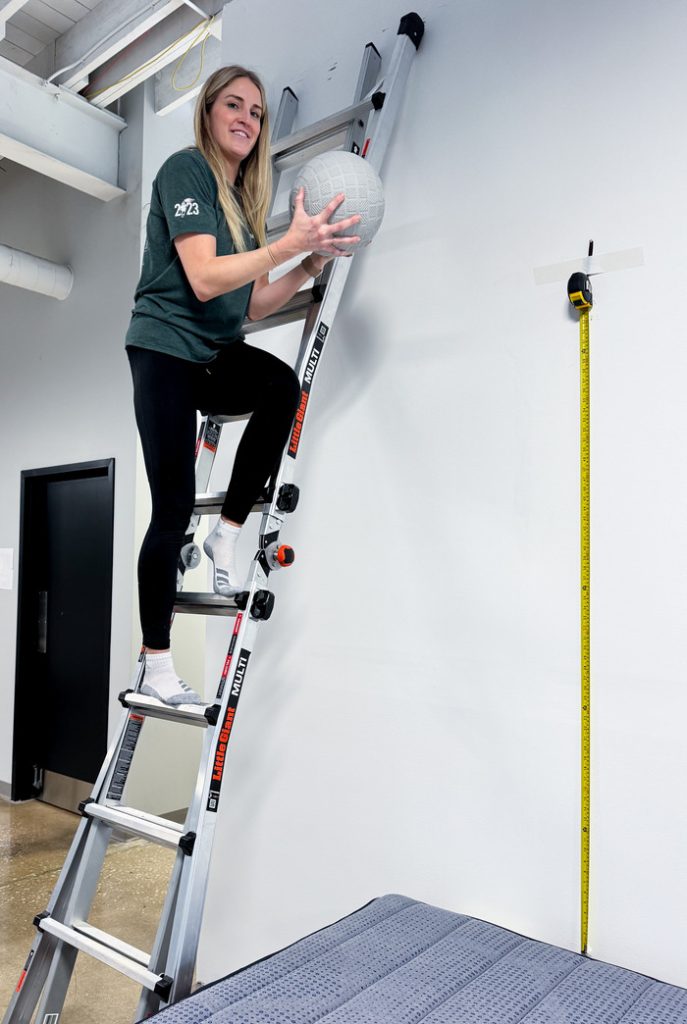
Our average bounce measurement hovers around 16 inches in height. We use this as a benchmark to assign a bounce rating to the bed: Low, Moderate, or High.
Noise
This can be an important category for anyone who’s a restless or sensitive sleepers, as well as for sexually active couples.
We assign a noise score between 1 and 5 to each mattress. If a bed makes noise when we move around on top of it, its noise score will be low.
Sex
A mattress that’s good for sex has to have a combination of qualities: high responsiveness, good edge support, and no noisiness. Therefore, to assign a score for a bed’s suitability for sex, we average its response, edge support, and noise scores to get a new score between 1 and 5.
Customer Experience Testing
In addition to testing beds for various performance aspects, we also test them for customer experience. These tests show us how convenient or difficult it might be to order, return, and set up a mattress.
Trial Period
When you order a mattress online, you’re usually given a window of time in which you can try it out at home for several nights. This is the bed’s trial period, or sleep trial. Typically, you can return a bed with little or no fee if you’re still within this period.
We give mattresses a score between 1 and 5 for their trial periods. Longer trial periods—lasting several months to a year—get a higher score.
Warranty
A mattress’s warranty ensures that you won’t have to pay for a mattress that’s damaged or has faults in its construction. Generous warranties apply for more than 10 years, and allow you to return, exchange, or get reimbursed for a bed that shows evidence of wear and tear beyond what would be expected from normal everyday use.
It’s important to read the terms of your mattress warranty before you order, so you know what to expect. For example, certain companies have warranties that will cover the cost of your mattress if it sags a certain amount after you buy it.
We give beds a warranty score between 1 and 5 depending on the warranty’s length and terms.
Unboxing and Moving
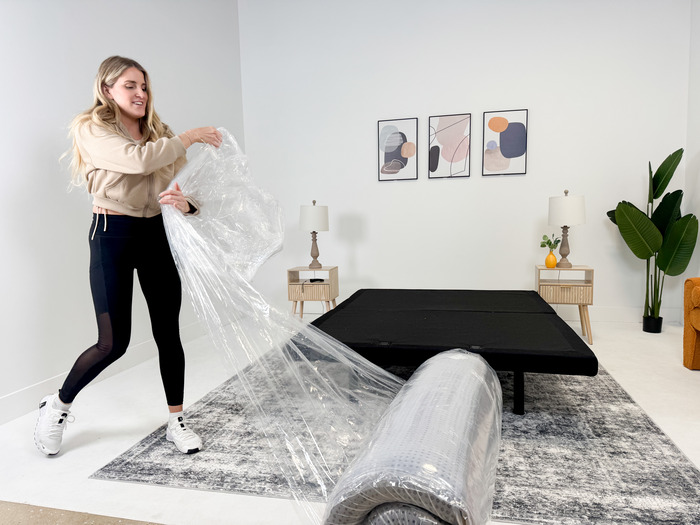
When a mattress is delivered to home, often you’ll have to unbox it and lift it to sit on a frame. We keep track of how difficult or easy the unboxing process is, as well as how cumbersome it is to lift and transport the bed.
We then assign a score between 1 and 5, with 5 indicating a seamless transition from box to bedroom.
Readiness After Unboxing
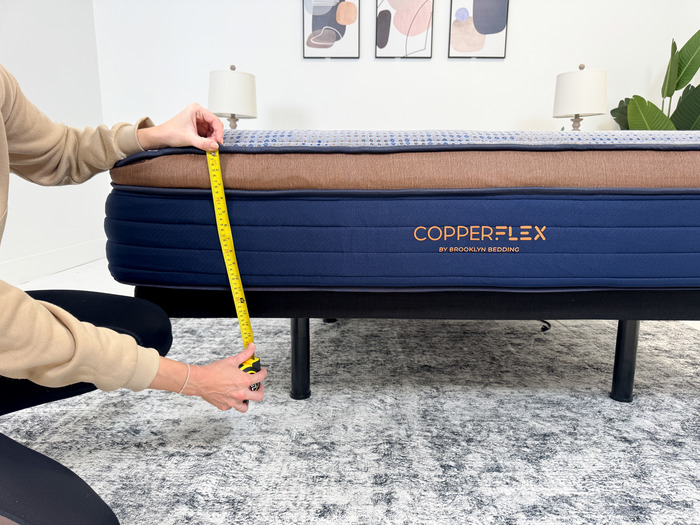
Mattresses usually need time to expand when they’re unboxed and freed from other packaging. In our testing environment, we keep a close eye on newly unboxed mattresses to time how long it takes for them to expand fully. We score them on a scale from 1 to 5, with 5 indicating an expansion time of less than 24 hours.
Off-Gassing
When you open a new bed-in-a-box mattress, you may notice a slight chemical smell. It often takes about 48 hours for this odor to dissipate.
When we test bed-in-a-box mattresses, we pay close attention to the strength of this odor and how long it takes for it to fade away. We’ve noticed that, in general, all-foam mattresses take longer to off-gas than innerspring beds. All-natural latex mattresses tend to have a mustier “barnyard” smell for the first few days.
We assign the bed a score from 1 to 5 in this category, with 5 meaning we barely noticed any smell, and 1 meaning it took more than 3 days for the smell to wear off.
Here’s more information about mattress off-gassing, and what you can do to get rid of the “new mattress smell.
Overall Score
At the conclusion of all our tests, we calculate an overall score between 1 and 5 for the mattress. This number is a weighted average of both performance and customer experience scores. If a mattress scores around 4 or above, then our testers and experts consider it a high-quality, high-value bed.

